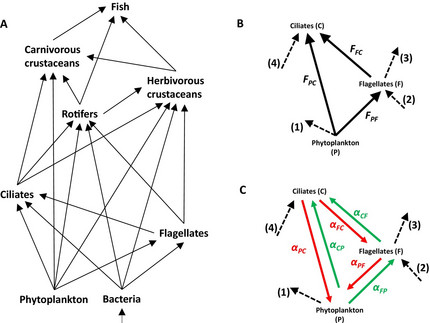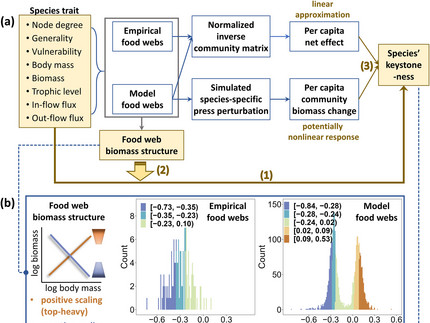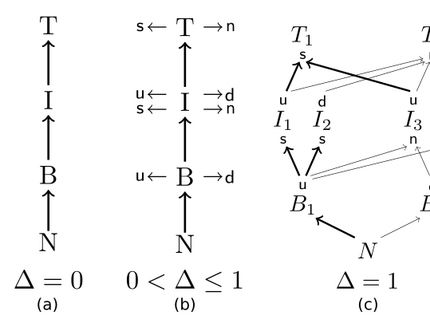Structure, stability and functioning of food webs
1. Drivers of stability in natural food webs
Natural food webs are remarkably stable despite highly variable environmental factors and populations densities. Building on 7 years of high-frequency observations of biomasses and production of the main trophic groups of Lake Constance's pelagic food web, we aim at uncovering the mechanisms driving this stability. To this end we investigate how the structure of the food web as well as its asymptotic stability change over time. We assess stability through maximum loop weight, which is based on the average interaction strength of positive feedback loops within the food web and thus is tightly coupled to the food web's structure.
The loop weight approach enables us to analyse biotic and abiotic drivers of food web stability. Key to this analysis is to quantify the embedding of the heaviest loop in the food web. For this, we consider the 'openness' of the heaviest loop, which depends on the ratio between the fluxes going in or out of the loop and the sum of all fluxes entering or leaving the respective trophic guilds.
Results of this project, which was supported by the Humboldt Foundation, have recently been published in Ecology Letters [link to study].
2. Keystone species - what determines how important they are?
Keystone species are defined by having a disproportionately large effect on the community when their abundances change in response to a perturbation (e.g., direct exploitation, habitat loss, or changing climatic conditions). This makes them an important target for conservation efforts and ecosystem management. Being able to reliably identify keystone species is thus clearly important, yet there are conflicting results on the species' traits (e.g., how well connected they are to the rest of the food web) that determine their keystone-ness.
We use a large data set of 144 empirical food webs that provides estimates of species' average biomasses and quantitative mass-balanced fluxes between them to calculate linear approximations of the net effects species have on each other and we complement this data with direct simulations of the non-linear population dynamics of model-generated food webs. This allows us to assess species' keystone-ness with two independent methods and to expand the range of scaling between species' body mass and biomass (i.e., how bottom-heavy or top-heavy the biomass distribution in a food web is). A key finding is that the relationships between species' energetic or structural traits and their keystone-ness are highly context dependent and may even be opposite in food webs with bottom-heavy or top-heavy biomass distribution.
This study was recently publised in Ecology Letters [link to study].
3. Trait adaptability and the stability and functioning of food webs
Functional traits of species that determine their interactions with others, e.g. defensive strategies or specialised offensive capabilities, are not static but can change over time by various mechanisms, ranging from phenotypic plasticity to evolutionary adaptation. Using small food webs with up to three trophic levels we have shown that functional diversity, especially at the level of the top predators, enables adaptive and compensatory dynamics throughout the food web that allows for efficient biomass transfer along the food chains (study 1, study 2). Furthermore, evolution of a single species in response to a perturbation overwhelmingly affects the survival of other species, with both positive indirect effects (evolutionary rescue) and negative indirect effects (evolutionary murder) being far more frequent than the corresponding self-effects (study 3). It remains, however, unclear how these observations scale up to large, complex food webs with realistic structure.



